 June 2014 Tank of the Month
June 2014 Tank of the Month
June 2014 Tank of the Month
Andrew Sandler's (hedgedrew) 900 US-gallon Reef Aquarium
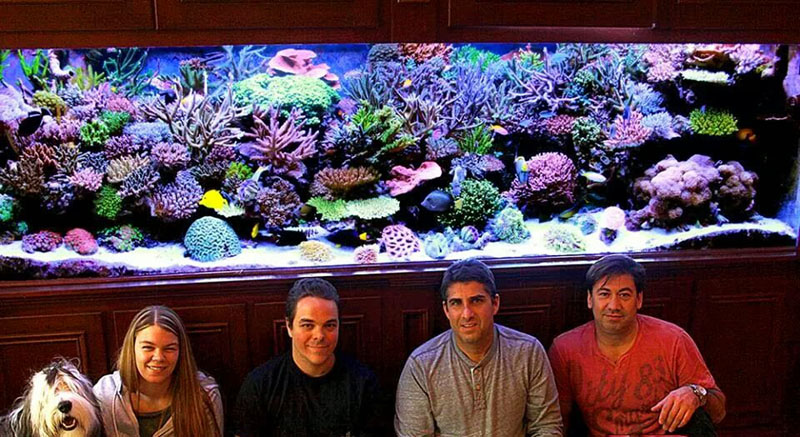 |
Introduction
I am honored to be selected June 2014 Tank of the Month. I thank Reef Central and all the great subscribers and hobbyists that participate in this wonderful forum. I have certainly learned a great deal from the dedication of active participants especially in the Reef Chemistry, SPS, and Large Reef forums. I also would like to thank Reefkeeping Magazine for allowing me to share my tanks and support me in this honor.
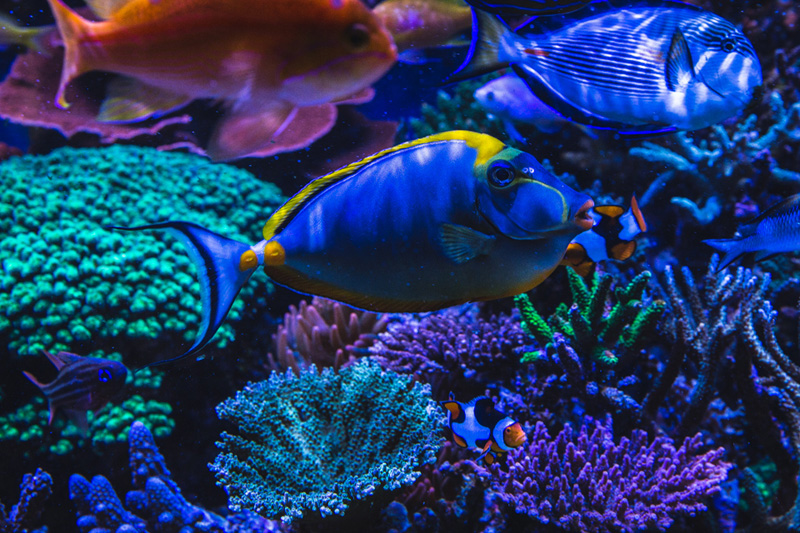 |
Background
I started in this hobby very young, maybe 10 years old. My grandfather started me off with my first 20 gallon fresh water tank where it began with live bearers... From there it went to bigger and multiple tanks. As a 12 year old, I was raising and breading discus, and African cichlids. By the time I was in high school I converted the 55 gallon cichlid tank to salt water where I had reasonable success with marine fish, back in the days with under gravel filters..
As college called I had to suspend my hobby but left instructions for my dad while I was away in school. Needless to say, it didn't work out so well and the tanks were eventually broken down. My senior year in college I moved into someones house who had a fish tank with one of those new for the time wet dry drip tray systems. My passion for the hobby reblossomed. I successfully kept my first partial reef tank senior year at University Wisconsin - Madison.
After college I settled down in Manhattan where I had two Clarity Plus tanks, one reef and one marine fish only. I'll never forget the anxiety of removing my DLS and bioballs and just relying on the live rock. I became an instant reef convert. We moved three times over the next ten years in NYC each time breaking down and resetting up both tanks. At the last building, one night I got a call from the super in the middle of the night ranting to me that water was pouring down 3 floors below us. I rushed out of the master bedroom and I was met with water up to my ankles. My RO/DI machine blew a gasket and water was spewing full blast all night everywhere, except in the water change bucket. Needless to say I was politely asked to leave the building. So off to the suburbs we went where I could build a house around big custom tanks. During the build, we lived in a town house around the corner from the new home construction, where I kept a full blown 200 gallon reef that we lost in the 2003 large east coast power outage. Lesson learned right away about backup generators in the future.
A few years later we had two 800 gallon tanks and a new custom home. I set up one of the tanks mostly SPS dominated and the other one soft corals. This is where I got my real experience with reef keeping and complicated skimmers, reactors, refugiums and other issues such as control and transfer switches to generators. Over the years I must have tried every combo of metal halide bulb and ballast out there and started to really reference Sanjay's lighting site. It’s also where I started to put angels and other non-reef fish together to experiment which angels ate what corals. Unfortunately, my first marriage ended badly and abruptly. I was forced to move out and basically break the two tanks down after a few years.
A few years later with my new fiancée, I was back in business. This time the challenge was two-fold. How do I build this reef with proper electrical, generators, PVC plumbing, lighting timers, and separate HVAC in equipment rooms all within a rental house that I knew I would only be living in for 3 to 4 years max!!!! The other challenge was to get as many species of fish, including angels, in one system for the time being as I did not expect this to be more than one tank. Both challenges were met and the birth of the system occurred the summer of 2011. As some of you know we have bought a new house that will create even more challenges, which I hope to share with you some day in the future. As this tank today gets broken down over the next year it will be reborn in two much larger tanks.
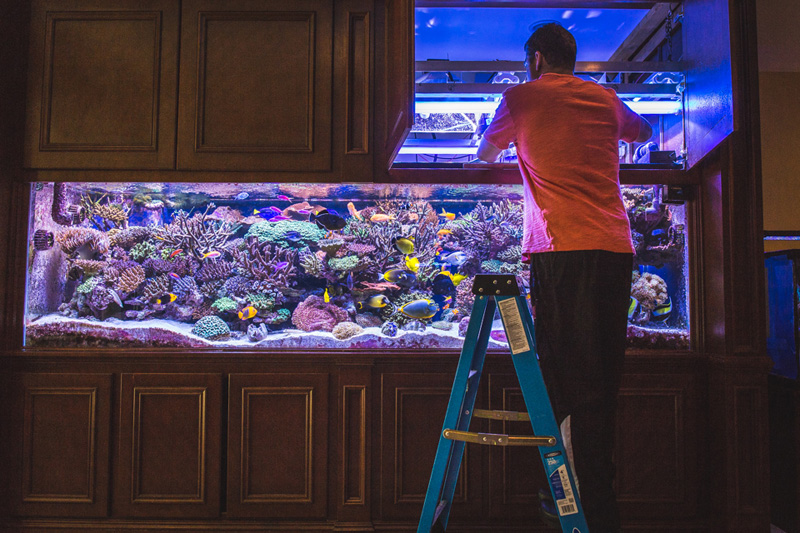 |
System Profile
• Main Display Aquarium: 900 gallon (10 ft x 3.5 ft x 3.5 ft)
• Lighting: T5’s, VHO actinics, Kessel LEDs, and 2-400watt halides in each Luminarc reflector (total of 8 MHs)
• Sump: Custom 300+ Gallon with multiple chambers
• Flow Main Display: 1.5 HP dolphin pump (12,000 gph), 1/2 HP Bermuda pump on closed loop 3-way motorized ball valve, x3 MP 60s
• Skimmers: Custom Bermuda skimmer 9 ft x 18", Precision Marine dual beckett skimmer for ozone
• Reactors: GFO canister x2, Rox carbon canister, calcium reactor x2
• Butterfly Aquarium: 180 gallon
• Lighting: multiple blue LED strips along with 14k 400w Aqua Connect halide x3
• Peppermint Aquarium: 90 gallon aquarium
• Lighting: blue and white LED strip
• Quarantine Aquarium: 60 gallon isolated system using bioballs running copper or praziquentel
• ATO: Spectrapure Liter Meter III
• Chiller: 2HP JBJ chiller
• Flow Other Displays: The other aquariums use a circulation pump coming from the sump and additional MP 40s or MP 10s
The Current System
The main display tank is just about 900 gallons measuring 10 ft x 3.5 ft x 3.5 ft. It is connected to a sump that is located 50 feet down the hall in a filtration room. The sump was custom made from a combo of PVC material and steel. The sump holds 300 plus gallons and has several chambers. Basically it goes through six filter socks and with two skimmers attached. The big beast is a custom 18” x 9 ft Bermuda skimmer, with a dedicated pump rated at 10,000 gph. This is just for the skimmer and was made initially for my prior tank in the old house. The other is a Precision Marine dual beckett system I originally ran for dedicated ozone. The water splits off to a 2 HP JBJ chiller and an 80 gallon refugium tank in a loop and all water going back to the main display goes through a 400 watt Viper UV sterilizer. Along the way we have added several tanks that attach to the sump or are split off from main PVC returns.
There is a 180 gallon on the system with SPS corals and predominately butterfly's, and a separate reef safe 40 gallon breeder I can put coral like acans and lobos with fish that don't eat them. In the 80 gallon refugium, I also grow chaeto and keep some clams that the angels don't bother. Lastly, there is a 90 gallon tank dedicated to housing deep water peppermint angels (Centropyge boylei) with dedicated chillers on a closed loop, to keep the water slightly cooler. All together with display tank, sump, skimmers, and supplemental tanks on the system, we estimate the total water volume at over 1500 gallons. The main display is SPS dominated big time. There are tons of large angels in the tank that would eat anything soft and fleshy. It’s even hard to keep tridac clams as the angels bother them and prevent them from opening. While there is tons of SPS in the background there is a huge emphasis on both diversity and rareness of fish including fish like: gem tang, bandit angel, conspicuous angel, blue line angel, gold flake angel, pair of regals, clarion angel, blue face and annularis angel, majestic angel, asphur angel, etc. A lot of people are amazed and have asked me how did I get all those in there without fighting and with live coral.
It's sort of obvious with this many fish, we would need a quarantine - hospital tank that runs on a separate system with bio balls. That tank is 60 gallons and either has praziquantel or copper running in it at all times. Its amazing how many butterfly's especially, I have to snag at night and throw into the copper because they come down with ich. Catching them is the issue. Not curing them. We use the old time unchelated copper sulfate with citric acid at about 0.15 to 0.20 ppms. Separate formalin baths with quick cure are also helpful in certain cases. In the future, we will be building many more and bigger quarantine tanks with separate tanks for observation only, tanks with copper sulfate, tanks that run praziquantel pro for flukes and even a separate one for antibiotics.
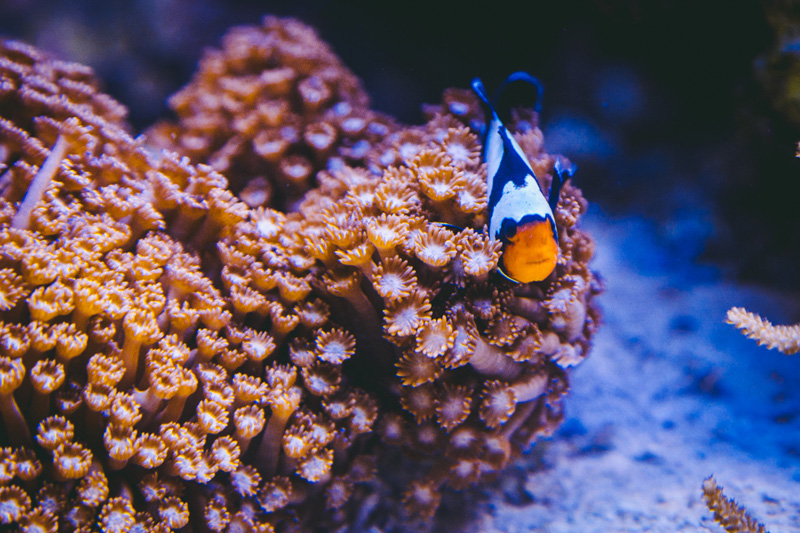 |
Equipment & Lighting
We run several reactors connected to the sump as well as the 2 aforementioned skimmers. Two GFO reactors filled with about 8 cups each of Rowaphos, that get changed every 2 weeks in rotation. This way phosphates stay more stable without stripping the tank if I change both at same time. There is a small carbon reactor filled with few cups of Rox 0.8 carbon and we run 2 bags of carbon passively in the sump. Again the idea is to rotate the change so one bag at a time gets changed and then the reactor every few weeks.
We use a combination of lime water for evaporation in an enclosed garbage BRUTE container controlled by a Spectrapure Liter Meter 3 which doses about 8 gallons per day of lost evaporation. In addition, two medium sized calcium reactors are hooked up to CO2 gas with Milwaukee pH controllers, which are dialed in with a pH around 6.8 and filled with ARM media. Together with the limewater, the alkalinity and calcium stay stable.
Lighting on all the tanks except the peppermint angel tank, are a combo of metal halides and supplemental blues. The large SPS display has T5’s, VHO actinics, Kessel LEDs, and 2-400watt halides in each Luminarc reflector. So a total of 8 metal halides within 4 reflectors. We are using a combo of 20k Radiums on HQI ballasts along with Hamilton 10k on electronics essentially mixing 20k with 10k making our own 800 watt 14 to 15k bulb mix. The 180 gallon has blue led strips along with 3 -14k 400w Aqua Connect halides. The 40 gallon has the same set up with one bulb and one reflector. The 80 gallon breeder is used as a refugium for chaeto and a clam tank where we run 2 -400 watt halides. On the side with chaeto macro algae, we use Hamilton 5500k plus. And on side with clams we are using an Ushio 14k. The peppermint angel tank has basic blue and white LED strip as we keep that tank very dim. The corals in that tank are lower light corals such as sponges.
Flow
The main display has the main return pump as a 1.5 HP Dolphin pump that returns into 4 different outlets, moving 12,000 gph. Two of these returns are 1.5” rotating Sea Swirls. In addition the tank has a half HP Bermuda pump running a closed loop with 4 different 1.5” returns controlled by a 3-way motorized ball valve. And lastly we are using 3 MP 60s for supplemental flow. The other supplemental tanks all use some sort of circulation pump coming from the sump and additional MP 40s or MP 10s.
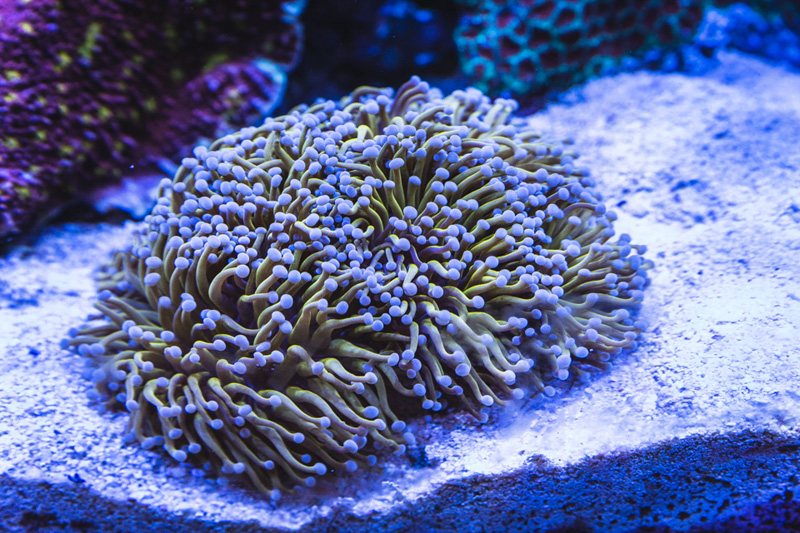 |
Maintenance
Daily
- Fish are fed 3 - 4x per day with mostly frozen and a combination of nor, flakes, and vitamin soaked pellets. We also use Arctipods and other Reef Nutrition foods for our smaller anthias and peppermint angels. Checks are made for fish health and appetite.
- Visual inspection for parasites and ich.
- Skimmer necks are wiped clean.
- Morning and afternoon checks of vital functions such as temperature, water levels, and pump operations.
- Manual dosing of vodka / vinegar - approximately 115ml of vodka equivalents dosed a few times per day.
- Acro power amino acids and Pohls xtra color additive by KZ every morning. Hatching of live baby brine every morning to feed anthias and peppermint angels.
Every other day
- Alkalinity tested. Since we carbon dose with vodka and vinegar we like to see our alkalinity stay between 7.5 dkh and 8.5 dkh. Glass windows are cleaned with magnets and scrapers.
- All 6 filter socks are changed. Old ones are power washed and put to soak in hydrogen peroxide then go through a separate wash cycle in dedicated washing machine in filter room.
Weekly
- Nitrate and phosphate tested.
- 15 percent water changes are done that come off a 400 gallon water change system with dedicated chiller and circulation pump. Literally just a valve turn to drain sump water to the outside septic system and a valve turn to pump new salt water into sump from the holding vats.
- Every few water changes we will siphon the very top layer of our deep sand beds and re add sand as well as siphon overflow boxes and the sump.
- Cleaning of overflow boxes and teeth to make sure water flow is proper.
- Half dose of Elos trace elements and ESV iodine added as well as Pohls k balance.
Every 2 weeks or monthly
- Carbon changed but never all at once. We will change the passive bags first and wait at least a week for the reactor.
- Gfo change. Again never both reactors at once. One at a time about every 2.5 to 3 weeks rotated.
- Probes cleaned and re calibrated for ORP and pH even though we don't run ozone any more.
- Detritus siphoned from peppermint angel tank and refugiums and separate water changes made.
- Calibration of refractometers
|
Water Parameters:
|
Reef Inhabitants
Main display - 900 gallons
- Blonde Naso tang - Naso elegans
- Gem tang - Zebrasoma Gemmatum
- Achilles tang - Acanthurus achilles
- Purple tang - Zebrasoma xanthururm
- Powder blue tang - Acanthurus leucosternon
- Pyroferus tang - Acanthurus pyroferus
- Powder Brown tang - Acanthurus japonica
- Red Sea Sohal tang - Acanthurus sohal
- Black tang - Zebrasoma rostratum
- Pair of regal angels - Pygoplites diacanthus
- Bandit angel - Apolemichthys arcuatus
- Blue line angel - Chaetodontoplus septentrionalis
- Interruptus angel - Centropyge interruptus
- Clarion angel - Holacanthus clarionensis
- Blue angel - Holacanthus bermudensis
- Asphur angel - Pomacanthus asfur
- Goldflake angel - Apolemichthys xanthopunctatus
- Majestic angel - Pomacanthus (Euxiphipops) navarchus
- Joculator angel - Pomacanthus semicirculatus
- Annularis angel - Pomacanthus annularis
- Blueface angel - Pomacanthus xanthometopon
- Female bellus angel - Genicanthus bellus
- Flame angel - Centropyge loricula
- Juvenile emperor angel - Pomacanthus imperator
- Male fairy wrasse - Cirrhilabrus sp.
- Scott's wrasse - Cirrhilabrus scottorum
- Mystery wrasse - Pseudocheilinus ocellatus
- Possum wrasse - Wetmorella albofasciata
- Hooded fairy wrasse - Cirrhilabrus bathyphilus
- Walsh fairy wrasse - Cirrhilabrus solorensis
- Red Margin wrasse - Cirrhilabrus rubrimarginatus
- Orange Back wrasse - Cirrhilabrus aurantidorsalis
- Black durgeon trigger - Melichthys niger
- Pair of Snowflake clowns - Amphiprion ocellaris
- Pair of Orange Skunk clowns - Amphiprion sandaracinos
- Pair of Black Percula clowns - Amphiprion percula
- Pair of True percula clowns - Amphiprion percula
- Red Candy Hog fish - Bodianus bimaculatus
- Red Sea Cleaner wrasse x2 - Labroides dimidiatus
- Moorish Idol x3 - Zanclus cornutus
- Fireball angel - Centropyge bispinosa
- Hybrid Tigepie angel - Centropyge eibli x Centropyge flavissimus
- Hybrid Lemonpeel angel - Centropyge flavissimus X Centropyge vroliki
- Deep-water Yellow Coral Beauty - Centropyge bispinosa
Schools of:
- Yellow tangs - Zebrasoma flavescens
- Purple Queen anthias - Pseudanthias tuka
- Bartlett anthias - Pseudanthias bartlettorum
- Randall anthias - Pseudanthias randalli
- Red Striped anthias - Pseudanthias fasciatus
- Blue chromis - Chromis viridis
- Bar gobies - Ptereleotis zebra
- Blue Eye Striped cardinals - Zoramia leptacantha
- Blue Hippo tangs - Paracanthurus hepatus
180 gallon inhabitants
- Large Conspicuous angel - Chaetodontoplus conspicillatus
- Regal angel - Pygoplites diacanthus
- Gem tang - Zebrasoma Gemmatum
- Smaller Bandit angel - Apolemichthys arcuatus
- Juvenile French angel - Pomacanthus paru
- Goldflake angel - Apolemichthys xanthopunctatus
- Multicolor angel - Centropyge multicolor
- Potter's angel - Centropyge potteri
- Female Watanabe angel - Geniacanthus watanabe
- Semilarvatus Butterfly - Chaetodon semilarvatus
- Red Sea Red Pearl Scale butterfly x3 - Chaetodon xanthurus
- Wrought Iron butterfly x2 - Chaetodon daedalma
- Tinker's butterfly x2 - Chaetodon tinkeri
- Red Sea Racoon butterfly x2 - Chaetodon lunula
- Burgess butterfly - Chaetodon burgessi
- Pakistani butterfly - Chaetodon collare
- Altivelis butterfly - Coradion altivelis
- Pair of Phantom clowns - Amphiprion ocellaris
- School of male and female Lyretail anthias - Pseudanthias squamipinnis
- Earlei wrasse - Cirrhilabrus earlei
- Pelicieri hawk - Plectranthias pelicieri
- Panda butterfly - Chaetodon adiergastos
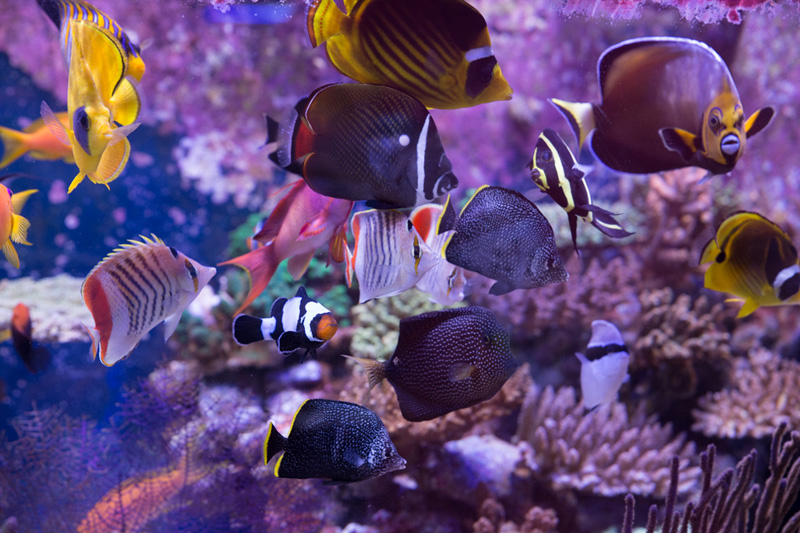 |
40 gallon inhabitants
- Pair of maroon gold clowns - Premnas biaculeatus
- Pair of frostbite clowns - Amphiprion ocellaris
- Small Yellow tang - Zebrasoma flavescens
- Swiss guard basslet - Liopropoma rubre
- Purple Firefish gobies - Nemateleotris decora
- Helfrichi firefish gobies - Nemateleotris helfrichi
- Multibar angel - Centropyge multifasciatus
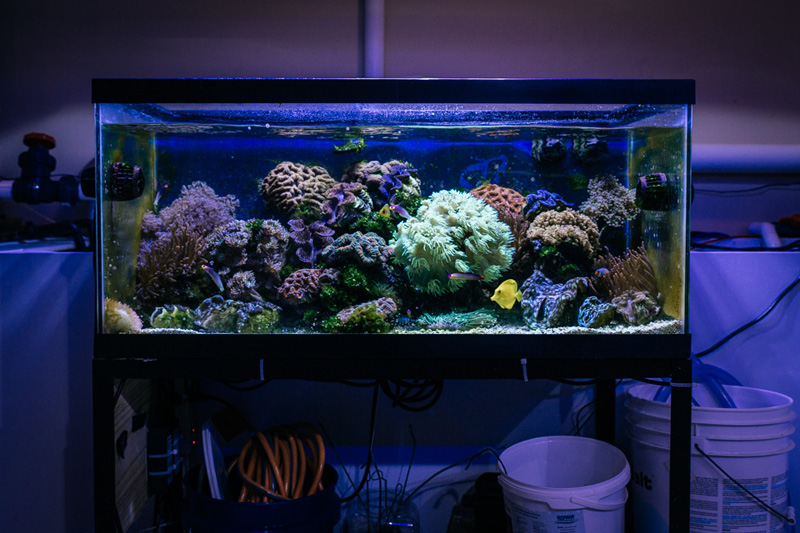 |
Peppermint Angel Aquarium
- Pair of peppermint angels - Centropyge boylei
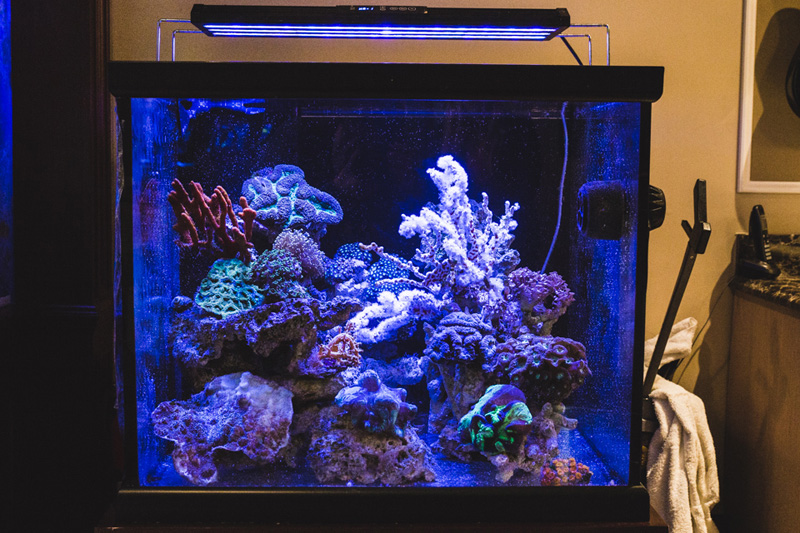 |
Challenges & Lessons Learned
STN of SPS coral that spreads really is a bummer, and we have had our share of losses. We have changed a number of things which we think has now minimized the problem.
- Avoid alkalinity swings
- Don't chase numbers.. its not important to have 0.03 phosphate if the GFO is just going to bleach out corals. Keeping phosphate stable and in a range is far better. We have even had better success at slightly higher phosphate numbers as high as 0.10ppm
- Smaller more frequent water changes are better than big ones.
- Change one thing at a time. Don't go changing your carbon on the same day as your GFO etc.
- Choose your mix of light you like and stay with it. Experimenting with bulbs is a bad recipe
- We feel that many acropora come from shallow waters and hitting them just with 20k lighting, while bringing out colors, is not the most beneficial and life-preserving way. We like mixing some white or even 14k in, even if it is for a few hours per day.
- Get into routine and stay with it. Change filter socks regularly and water changes on regular intervals. Same for carbon and gfo changes. Go easy and not on same day.
- Feed your reef. Make sure fish are getting plenty of food and we believe in amino acids a few times per week, nightly polyp feedings with a variety of coral foods- we make our own custom blend.
- Vodka and vinegar dosing just doesn't really cut it when you have so many fish and feed so often. Yes they help control levels. But we have had plenty of Stn trying to push up the dose to bring nitrate down further. Its simply not worth it. Again don't chase numbers. In our opinion a nitrate reading of 5 is just fine and one of 10 to 15 isn't really going to hurt anything.
- Make the investment in great equipment and great lighting. Its well worth the troubles ahead.
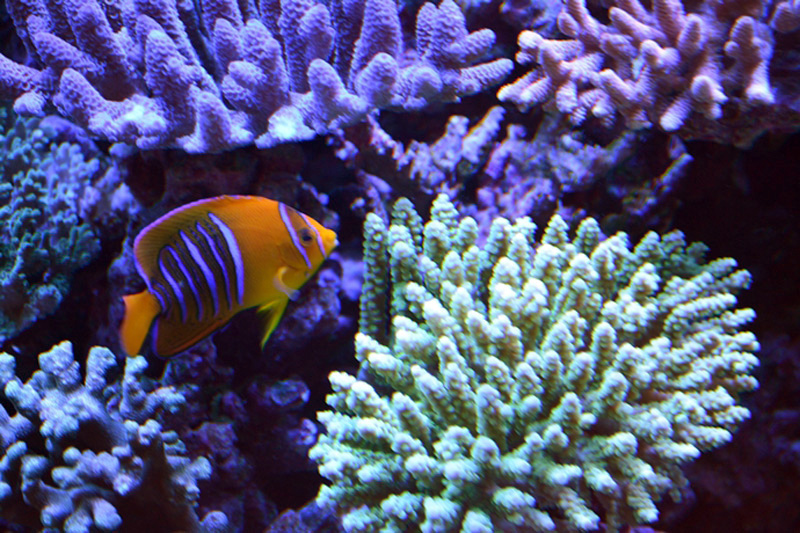 |
Conclusion and Acknowledgments
I must say while I had the dream and passion, this system would never have been built and properly maintained without the help of a few special people. First, I must thank Jonathan and the team at Country Critters in Patchogue, Long Island. Besides setting this baby up in a rental, Jonathan was there all the way as we expanded this system into the many supplemental tanks and was responsible for introducing me to the biggest challenge of all; keeping peppermint angels. On that subject my only comment is 'no pain, no gain'. Clearly these fish need a lot more study on diet how and maintenance of these in captivity, including transition from deep water. Its obvious we have had our share of expensive losses!!
Lastly, the system is maintained on a day to day basis by my loyal help Yalcin and his wife Handan, who have been with me for over 13 years. The dedication and hard work from them, climbing ladders and doing most of the daily laborious things that really make this tank shine, also gives me free time so that I am not a slave to the system. Changing large GFO reactors and rinsing Rowaphos is not a lot of fun!!! Without their help the system had no shot. Yalcin has turned into a passionate hobbyist and a pseudo reef master in his own right.
One final thanks to my new fiancée who has been so encouraging and supportive of this dream and passion of mine. Its great to have a partner who gets involved and enjoys reefing also.
Once again thanks for this honor and I can't wait for the next go around!!!!!!
 |
Feel free to comment or ask questions about my tank in the Tank of the Month thread on Reef Central.



